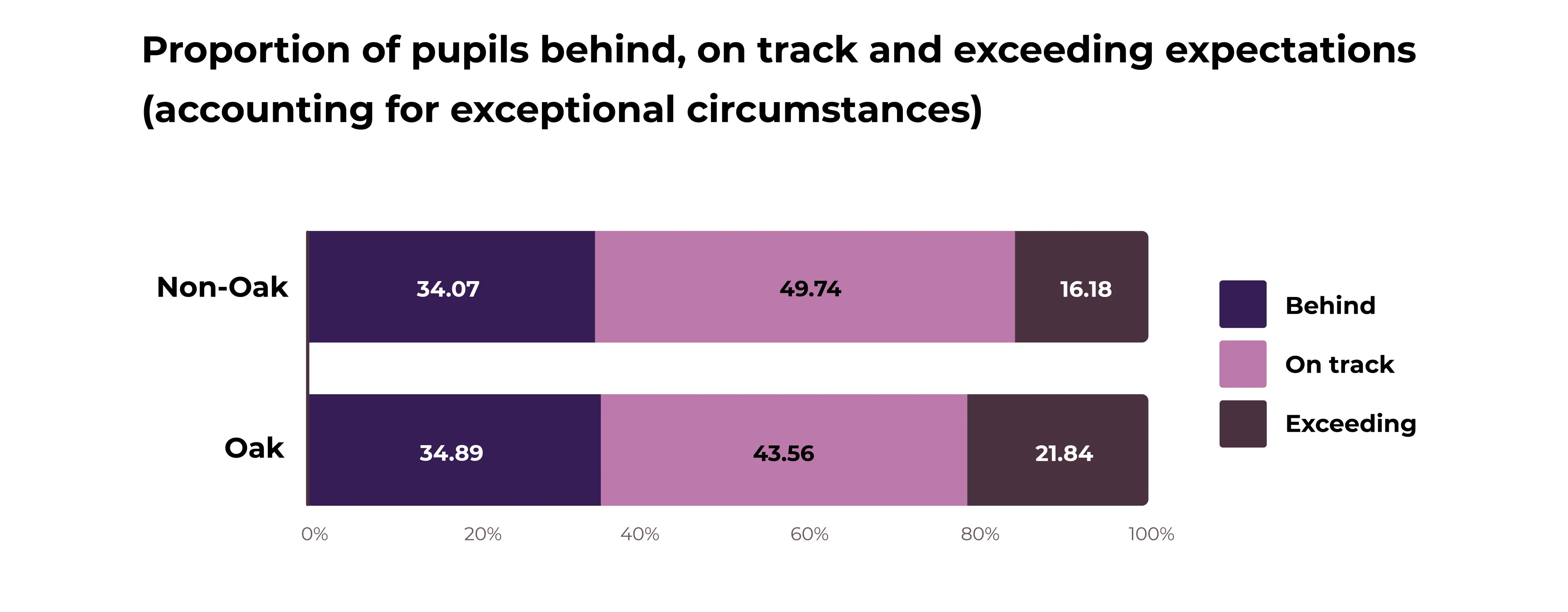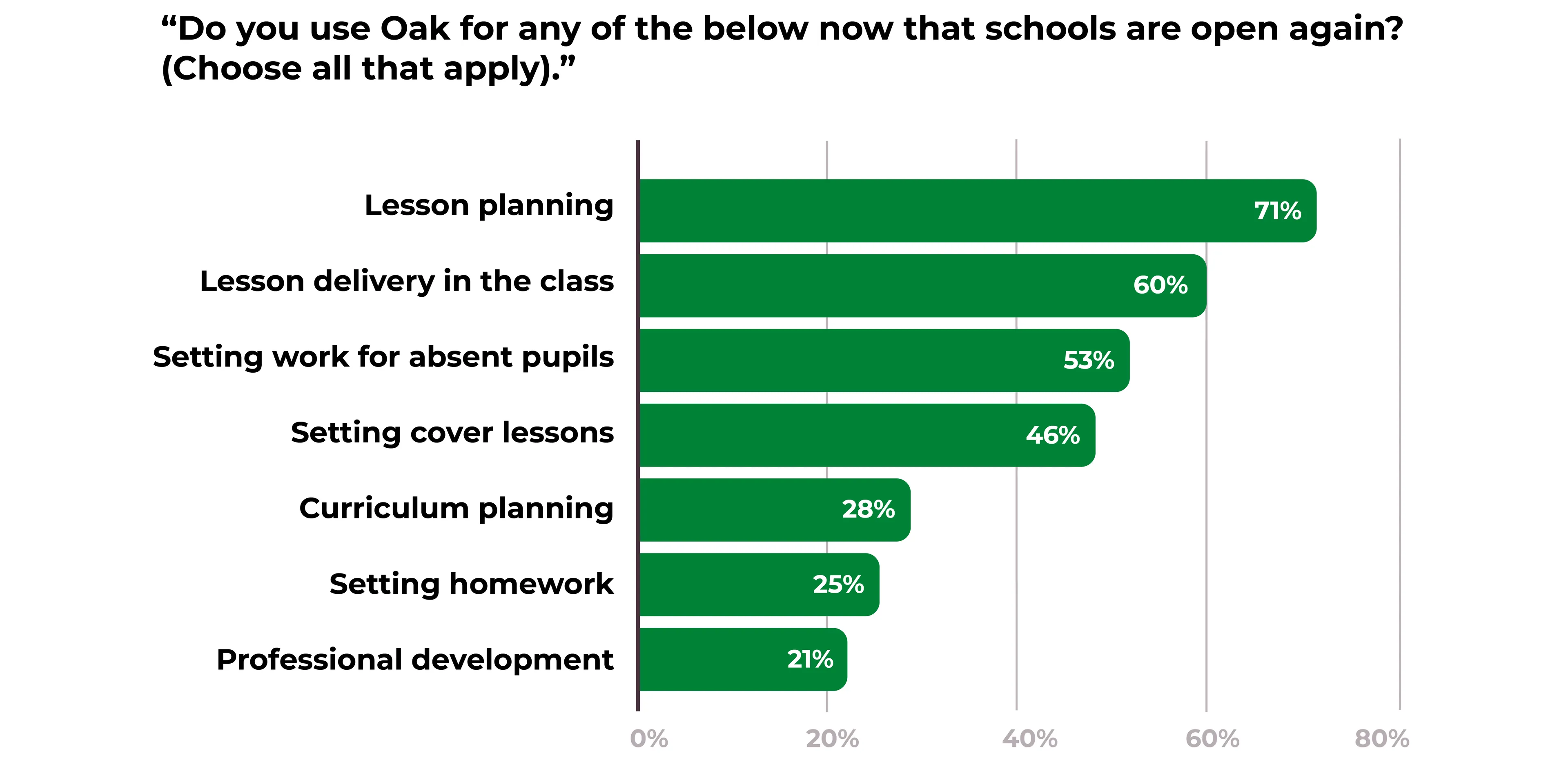
Categories
Research and insights
22 October 2021What impact did Oak have in 2020/21?

Matt Hood OBE
Chief Executive
Key findings from our annual report
Since April 2020, Oak has grown to become a trusted national resource supporting millions of teachers and pupils.
We supported teachers in 54.1% of all state schools in England throughout the 2020/21 academic year, delivering 110 million more lessons — figures beyond anything we could have anticipated.
With help from research conducted by ImpactEd, we’ve taken an in-depth look into not just the numbers, but how usage has translated into continued positive and measurable impact on pupils and teachers.
Here are just a few of the highlights from the full report.
Impact on teacher workload
Nine in ten teachers said their overall workload increased sharply from September 2020 when schools fully reopened. This increase was largely due to implementing stringent new safety requirements, managing remote learning for increasing numbers of pupils, getting to grips with new technology and also dispatching food parcels to families that needed them.
61% of teacher-users said Oak’s platform and resources saved them valuable time during these difficult months.
When asked validated questions based on the National Teaching Survey, responses showed that Oak users felt more positive about their workload and that having Oak resources had a notable impact on the amount of time they spent planning and resourcing lessons, allowing them more time to focus on identifying and supporting more vulnerable pupils during lockdown.
"I teach three different subjects (French, History and Geography) in a small school without proper Heads of Department. I can find everything here. I saved HOURS of planning."
Impact on teacher wellbeing
September 2020 brought with it an assumption teaching would be notably less stressful — school reopenings meaning the majority of pupils would be in school whilst small numbers isolated.
We now know, of course, that this wasn’t the case. On top of everything else, many teachers were essentially operating two schools as isolations increased in the autumn term: for those in the classroom, and those at home.
Strongly related to workload, the report also shows that Oak users reported statistically significant higher levels of wellbeing than non-users(1).
ImpactEd looked at the wellbeing of Oak users compared to both non-users and the Warwick Edinburgh Mental Wellbeing Scale (WEMWBS) national benchmark from 2020. Their finding was that Oak users had a statistically significant higher wellbeing score than non-users and scored on par with the pre-pandemic national average benchmarks.
Impact on quality of teaching
Our Education and Technology teams have worked hard to make sure that content, design, production and user experience of every lesson is continuously improving, and research shows us that 92% of teachers who used the Oak platform were satisfied or very satisfied with the quality of the content available.
This is reflected in the use of Oak both in and outside the classroom. 72% of teachers said that having Oak’s curriculum and resources improved the quality of their remote lesson delivery, while over half (56%) of teachers who use the platform said Oak helps improve the quality of their in-person teaching. 58% also said that Oak’s helped to improve in-person lesson planning.
Teachers say Oak has supported pupil outcomes. Still, our impact is affected by deprivation
Impact on pupil outcomes
88% of Oak user teachers said they were satisfied or very satisfied with the learning experience that Oak provides.
Research shows early promising signs around pupil progress. Teacher-users have told us that Oak has supported pupil outcomes. When asked what proportion of the pupils they taught were behind, on-track or exceeding expectations, 22% of Oak users, compared to 16% non-Oak users, reported pupils exceeding expectations — a statistically significant difference.

"I set Oak as an informal opportunity to access learning for a boy who had suffered a bereavement when he was ready, and as result he is now achieving in line with his peers."
Supporting schools in areas of high deprivation and social mobility cold spots
Committing ourselves to providing access to a quality education for all pupils during the pandemic meant we needed to actively address the existing imbalance of those already at a disadvantage.
We used the Social Mobility Index (SMI) to track Oak’s use in areas with lower and higher expected educational and life outcomes for young people — ‘cold spots’ vs ‘hot spots’. 58.7% of teachers said their pupils in these cold spots used Oak compared with 54.1% in hot spot areas. Further to this, Oak lessons were chiefly used by pupils in the 40% most deprived areas.
These children were helped by Oak's successful campaign to secure a zero rating of the site by mobile networks, meaning children could take part in learning without racking up big bills for mobile data.
What’s next? Teachers keep using Oak, not just for remote learning
Continued use of Oak and new use cases
Since April 2020, pupils have taken part in 130 million Oak lessons. 59% of state school teachers have used the site and its resources. Almost all teachers who use it (92%) said they were satisfied or very satisfied with the quality of the content, and 73% per cent would recommend it to fellow teachers.
We asked teachers how they felt about using Oak in the future, and three in four of those teachers told us that they plan to carry on using our resources this term and beyond, with many pointing to how the platform has improved their teaching in the classroom.
Further research into how Oak is being used in the classroom found that lesson planning is by far the most popular task, followed by using resources in the classroom, setting work for absent pupils and for cover lessons.

Oak survey with 431 teachers (May 2021)
And what next for Oak?
Our research shows Oak helped saved teachers valuable time and improved their wellbeing during a particularly difficult time.
But it also shows that, now that they've taken on and conquered technology over the pandemic, teachers intend to carry on using our resources now they're back in the classroom.
We want to continue with our aim to free teachers up to focus on working directly with pupils – by sharing high-quality, curriculum-aligned materials, created by fellow colleagues.
Oak was built by teachers, for teachers, and this will continue to be the case as we develop and evolve.
We will always make sure to share updates when we have them. You can subscribe to our mailing list to ensure you're using our latest features.
Full details of all the research and impact report are in the Annual Report. You can find the full report here.
Footnotes
(1) Warwick Edinburgh Mental Wellbeing Scale. Oak-users’ well-being was scored at 45.9 using this standard national testing system. A score of 45-59 represents average mental well-being. This compares with non-Oak users scoring 43. The pre-pandemic figure was 45.7
(2) Using the Income Deprivation Affecting Children Index (IDACI) The largest group of Oak users were in the second most deprived quintile and the second largest group of users in the most deprived quintile, widely regarded to be the most difficult to reach and engage

